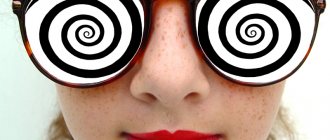Our Hypnosis Center provides treatment for panic attacks using hypnosis. Today, the percentage of patients who suffer from panic attacks is very high. Panic attacks that “cover” them for a long period prevent them from living a full life. Panic attacks are always associated with enormous stress, and the saddest thing is that not every doctor is able to help the patient who comes to him cope with them.
A panic attack is an attack that can occur in a patient at different intervals. It is characterized by the following symptoms:
- anxiety, often appearing for no apparent external reason, sometimes developing into real panic;
- accelerated heartbeat;
- pale skin;
- the appearance of a “lump” in the throat;
- shaking limbs;
- dizziness
In addition, some people may experience other, individual manifestations of panic attacks.
At the present stage, hypnosis is used as one of the most effective methods of combating panic attacks, since it is aimed not at relieving unfavorable symptoms, but at eliminating the root cause of the attacks. Like other types of nervous disorders, panic attacks should be studied in depth, carefully considering the reasons for their occurrence. Drug therapy, which is most often prescribed in medical institutions, only helps relieve symptoms. Treatment of panic attacks with hypnosis involves completely different mechanisms. It is assumed that with its help the doctor will be able to find out the reason that provokes such a condition, even if the patient himself does not know about its existence. Focusing on each individual patient, doctors help the person who comes to them to start living life to the fullest again without fear of possible panic attacks. Hypnosis solves the problem radically and forever.
Panic attacks: treatment with hypnosis
Panic disorder is a disorder characterized by the spontaneous occurrence of panic attacks several times a year to several times a day and the anticipation of their occurrence. A panic attack is a trance-like state in the form of an inexplicable and painful attack of severe anxiety and severe fear, combined with various vegetative symptoms, which are most often perceived by the patient as deviations in the functioning of his body or as symptoms of a disease. Among these symptoms are:
- cardiopalmus
- nausea
- sweating and a feeling of warmth
- chest pain or tightness
- dyspnea
- dizziness
- feeling disconnected from reality (derealization)
At the same time, a panic attack is a frightening sight for others. This state can last from 5 to 20 minutes, and sometimes come in waves over two hours. Thus, a panic attack is a terrifying condition that occurs periodically in people with panic disorder or in people with agoraphobia when going out into the street or open spaces. A panic attack is an extreme form of natural fear that occurs in response to bodily changes.
● Psychocorrection of beliefs that support panic attacks. Tools: regression hypnotherapy and cognitive analysis. ● Review of scientific articles about the mechanisms of the occurrence and treatment of panic attacks. ● Treatment of panic attacks in cognitive therapy and hypnotherapy ● “I can’t...!” — psychological treatment of helplessness: from panic attacks to impotence"
Symptoms and signs
The signs and symptoms of a panic attack develop suddenly and usually peak within 10 minutes. They rarely last more than an hour, with most ending within 20-30 minutes. Panic attacks can happen anywhere, anytime. You may have an attack while you are in a store, shopping, walking down the street, driving in a car, or even sitting on the couch at home.
Panic symptoms can be so severe that people often believe they are having a heart attack or other life-threatening illness. Common symptoms include:
- chest pain
- nausea
- dyspnea
- heartbeat
- fear of death
- sweating
- dizziness
- shiver
- lack of air
- numbness
- headache
- exhaustion
- horror
The vicious circle of a panic attack
The mechanism of a panic attack can be represented as a vicious circle of our bodily reactions, thoughts and emotions. Suppose a person feels stuffy in a trolleybus. Most people will simply tolerate the discomfort and move on. However, there are also more sensitive people who are able to quickly and sharply focus on their bodily symptoms without understanding their meaning. In this case, when a person does not have enough air, he pays attention to the change in his breathing, to the beating of his heart, and he has the thought that something is happening wrong in his body, for example, that he is suffocating and may die. This thought leads to the emergence of fear, while the natural manifestations of fear are rapid heartbeat, shortness of breath, chest compressions, etc. Thus, the patient finds himself in a vicious circle: bodily manifestations cause fear, and fear only intensifies bodily manifestations, which ultimately ultimately leading to a panic attack.
Psychology of hypnosis #1. How to treat and create stuttering or other phobia in hypnosis?
Psychology of hypnosis #2. Hypnosis and suggestion in sports & Ideomotor training
Panic attack from within
What does it mean to experience a panic attack? Imagine that you are faced with a threat to your life. You are very scared, your heart begins to beat faster, your breathing quickens, your blood pressure rises, your muscles tense, preparing you to either attack or flee. Now imagine the same bodily manifestations happening to you without any external cause or real danger. This is exactly what happens to people with panic disorder. They either experience panic attacks due to acute or prolonged stress, or the panic attacks simply accompany their constant background anxiety. At the same time, when a person experiences symptoms of fear without the presence of any obvious external threat, he begins to interpret the symptoms of his fear in the most understandable way for himself: “Something is wrong with me,” “I’m suffocating,” “I’m going to die,” which as mentioned above and leads to an increase in fear and an even greater increase in symptoms.
Benefits of hypnotic treatment
Treatment with hypnosis is the highest quality and painless method of therapy and further elimination of panic attacks and their main symptoms. The task of timely treatment with hypnosis is to identify the source of fears and panic, eliminate it and switch the person’s subconscious to thoughts of a positive outcome. After treatment with this method, it is possible to rid a person of obsessive thoughts about a new attack and constantly waiting for it. Treatment in this way has gained popularity, since its effectiveness has been proven, and it begins to act after 5 sessions. This is an excellent remedy for quickly getting rid of panic attacks. From a person’s subconscious it becomes possible to eliminate the cause of unpleasant symptoms.
Even if the patient himself finds it difficult to remember the possible cause of such attacks, with the help of hypnotic sessions it can be identified and eliminated. Thanks to an individual technique that is tailored to each patient, there is a very high probability of returning to normal life, in which panic attacks will no longer be present. All symptoms that arise during an attack are evidence of a vegetative storm, which is provoked and pushed into the depths of the subconscious by psychological conflicts. The most common causes of this condition are unresolved internal or overt conflicts that occurred in childhood.
Causes of a panic attack
To date, the specific causes of panic attacks remain unknown, but there are suggestions about a number of psychological and environmental factors that provoke this disorder. According to the Royal College of Psychiatrists, there are four groups of factors that can cause anxiety problems: genetics, life experiences, current situation and substance misuse.
- Genetics . Genetic theory says that some people are simply born more anxious than others, and although there is not much research on this issue, most of it shows that there is a certain connection between the presence of this mental illness in children and in parents.
- Traumatic experience . The psychodynamic theory of psychotherapy suggests that panic disorder can be a consequence of a previously experienced traumatic event or a current stressful situation or crisis in a person's life, for example, moving, pregnancy, divorce, unemployment, etc. Thus, a person, as it were, expresses accumulated stress by transferring it from the original problem situation into a panic attack.
- Current situation . Sometimes, the causes of a panic attack can be quite obvious and arise from the direct impact of the situation. For example, a person may experience panic attacks during military operations. And in this case, if we remove the stressor, the panic attacks go away at the same time. Often, in case of prolonged exposure to a stressful situation, the disorder can take the form of PTSD (post-traumatic stress disorder).
- Psychoactive substances . Anxiety and panic can sometimes be provoked by certain psychoactive substances, including caffeine, which has a stimulating effect on the nervous system.
Treatment of panic disorder
It is worth saying that most people may experience a panic attack at least once in their lives, however, if in your case panic attacks occur frequently and with a certain frequency, you should contact a qualified specialist. But, before going to a psychotherapist of any kind, it is worth consulting with a doctor about the presence of real somatic diseases that can lead to the symptoms described above, and only when such diseases are excluded can you proceed to psychotherapeutic work. Among psychological types of treatment, two directions can be distinguished: cognitive-behavioral and psychodynamic. In both cases, hypnosis is used as an auxiliary and enhancing factor.
Contraindications for treatment with trance induction
If a patient is diagnosed with a panic attack, hypnotherapy may not always be useful or suitable for everyone. It is not allowed to put a person into a state of hypnosis against his own will. Even if the hypnotist or doctor himself is convinced that this is the only possible way to cure such attacks. In this case, it is necessary to talk with the patient and explain to him the benefits of this type of treatment.
There are no medical contraindications for hypnosis treatment
Introduction to a hypnotic state is always an intervention in the human psyche, and, as with any other method of influence, it has its risks.
Why hypnosis?
In addition to the fact that hypnosis, according to these studies, enhances the effect of any other psychotherapy, regardless of direction, the hypnotic state plays a special role in panic attacks. Studies of people with panic disorder show that such people are generally more hypnotizable. This shows that panic attacks are directly related to the state of hypnosis, and this is why hypnotic intervention may be more effective. In particular, panic attacks are trance-like dissociative states that appear to be a maladaptive defensive response to general anxiety. Hypnosis allows you to make such a state manageable and find the causes of hidden anxiety or change the very process of a panic attack.
Cognitive hypnotherapy
Cognitive behavioral therapy is aimed primarily at breaking the vicious circle of fear during a panic attack and eliminating the secondary benefits of this disorder. In particular, the symptoms of a panic attack are deliberately caused in a person in order to demonstrate their safety (for example, sudden squats can also lead to shortness of breath, rapid heartbeat and dizziness, however, they are not a symptom of the disease). Thus, the person comes to the conclusion that even when he observes similar symptoms outside the psychologist’s office, he will not die and everything will end well. There is also work with secondary benefits, when the patient is prohibited from calling an ambulance or calling loved ones during a panic attack (usually the attention of other people serves as reinforcement for panic behavior). As soon as a person stops receiving attention from the outside, his tendency to panic attacks decreases.
Throughout the entire process, the person undergoes cognitive restructuring, changing his beliefs about his health, the possibility of dying and the hopelessness of the situation. At this stage, cognitive hypnotherapy becomes extremely effective.
Cognitive hypnotherapy also focuses on cognitive restructuring, as well as relaxation, reducing anxiety and fear, and working with self-esteem. Suggestions made by the hypnotherapist are tailored to the characteristics of a particular patient and involve changing the client’s reaction to certain triggers that trigger a panic attack, as well as changing his ideas, thoughts and beliefs. Thus, the main task of the hypnotherapist is to instill three main ideas:
- “You have everything under control, and nothing can harm you” - this suggestion involves fighting the client’s most problematic thought during a panic attack: “Something is happening to me, I can’t do anything.”
- “Slow down your breathing, it will help you calm down” - this suggestion provides a real tool for combating a panic attack, and practicing it in hypnosis then makes it much easier to use when a real panic attack occurs.
- “You will get through this, just breathe” - this suggestion involves instilling in the client the belief that he will survive and eliminating the fear of death from the emerging symptoms of fear.
If hypnotherapy is carried out correctly, then these ideas will get into the client’s head and will be activated during the next panic attack, which will help overcome it. However, this is not just a matter of overcoming. This kind of internal work allows you to manage your attention during a panic attack. A person learns to notice the onset of a panic attack and the factors that cause it.
Moreover, in addition to suggestions and attention control, hypnotherapy is often used directly to teach relaxation, which can generally reduce the level of stress in a given patient, and teach him to relax during a panic attack, which will negate bodily symptoms.
Most often, the client is asked to carry out additional work in self-hypnosis. In the process of self-study, a person can also practice self-hypnosis and relaxation. Often a person in hypnosis is taught to move to a safe place, and then during the process of self-hypnosis he can say to himself a standard form of suggestion: “When I start to get nervous, I easily move to my safe place, which allows me to relax and calm down.” Sometimes an action is added to this, for example, when imagining a safe place, a person can clench his fist, and during the next panic attack he can do the same thing, which will help him relax.
Psychodynamic hypnotherapy
The cognitive-behavioral approach is often criticized for focusing only on relieving the symptom and not on eliminating its cause. We can indeed teach a person to breathe deeper during a panic attack, but it is not a fact that after that the next panic attack will never occur. We can remove panic and stress in one situation, but this does not mean that with new stress we will not get another panic attack. That is why the psychodynamic direction concentrates on finding the causes of panic disorder in the form of repressed traumas of our past. Such work is carried out in all areas of psychodynamic psychotherapy: psychoanalysis, Gestalt therapy, body therapy, etc. However, hypnosis allows us to speed up this work, since it greatly simplifies the search for repressed (dissociated) traumatic events in our memory due to increased concentration and immersion in the client’s imagination. Thus, regressive hypnotherapy proceeds in a number of stages.
- Induction. Induction is a method of inducing hypnosis, which allows you to immerse a person in one or another stage of this state, depending on the degree of his hypnotizability. Using special tests, a hypnotherapist can determine at what stage of hypnosis his client is, which will help him in further work.
- Plunge into a panic state. At this stage, the client is asked to recall a situation when he experienced panic and the sensations that accompanied it. This is done primarily to start a flow of associations and create a context through which it will be much easier to find the traumatic event that led to the disorder.
- Age regression. Using various methods of regression (remembering), the patient is immersed in increasingly earlier situations where a similar feeling of panic was observed. At the same time, the flow of associations increases and it becomes much easier for a person to remember those events that he would not remember in a normal situation.
- Processing psychotrauma. As soon as the hypnotherapist has discovered the client’s psychotrauma, its processing begins. It is carried out at three levels. At the emotional level, there is catharsis and a release of suppressed emotions that a person once failed to express and which he kept within himself all this time. After the emotion has been exhausted, a person can look at the situation soberly and change his thoughts, ideas and beliefs, i.e. processing occurs at the cognitive level. Finally, based on new ideas, you can move to the behavioral level and work out in fantasy a new way of behaving and expressing your emotions.
However, it is worth understanding that there are other options for working through traumatic events; however, the method proposed here is considered by the authors to be more effective, since it affects all levels of the problem.
- Age progression. With new beliefs and behavior, a person is transported to his current age and imagines how he will react during the next panic attack, thus programming his behavior. The hypnotherapist assesses the client’s emotional reactions and the need for further elaboration.
Other methods of hypnotherapy
And E. G. Abramovich and P. Lichtenberg proposed their own special hypnotic technique for the treatment of panic attacks called “Hypnotherapeutic olfactory conditioning.” This technique is aimed at eliminating the possibility of a number of odors causing panic attacks. And, here it is worth noting that odors are a fairly significant stimulus that can provoke a panic reaction, even when a person is not aware of it. During hypnotherapy, this technique teaches the patient to associate pleasant smells with a feeling of comfort and safety. Subsequently, the patient learns to use such associations in order to overcome panic and phobias. This technique can be effective for panic attacks provoked by post-traumatic stress disorder, when the patient’s panic is triggered by the smell. This technique has been tested and shown to be effective in a number of cases. There are also techniques for eliminating panic attacks in hypnosis for low-hypnosis clients. One of these techniques was proposed by A. Iglesias. It involves the use of hypnotherapy while awake by fixating the gaze on an object. In this state, the client is able to play out to himself and work out a number of strategies for responding to a panic attack and options for interrupting it.
Integrative approach
It is worth saying that the two methods described above are not mutually exclusive, but, on the contrary, complement each other, and are even necessary for each other. Indeed, very often, when the cause of the problem is eliminated, a person retains the same mental and behavioral habits, which leads to relapse. But the opposite can be said: when fighting the current symptom, the cause that gave rise to it can find its way out in another problem. That is why competent work is usually carried out both at the level of cause and at the level of symptom, when the traumatic experience is initially worked through, and then taught to cope with the current problem without hindrance.
The integrative approach also includes areas of influence that do not concern the psychologist’s office. In particular, D.B. Reid proposes a program for treating panic attacks consisting of five elements: first, an explanation of the mechanisms of development and occurrence of panic; secondly, studying the factors that trigger panic in a given client; third, encouraging physical activity; fourthly, the use of hypnosis; fifthly, tracking and monitoring progress in treatment. This complex effect allows a person to get rid of a rather complex mental disorder.
● Four causes of psychosomatic diseases ● Treatment of phobias using regressive hypnosis and hypnotherapy ● Treatment of phobias. Review of proven methods for treating fears and phobias. ● Psychosomatic diseases: causes, symptoms and treatment methods ● Hypnotherapy for the “unhypnotizable”. Emotional stress hypnotherapy
Hypnosis: a review of the treatment of body spots & fear of dating, social phobia. Reviews about hypnoanalysis.
Hypnosis: a review of the treatment of fear of riding the subway & psoriasis & social phobia
Integrative approach
It is worth saying that the two methods described above are not mutually exclusive, but, on the contrary, complement each other, and are even necessary for each other. Indeed, very often, when the cause of the problem is eliminated, a person retains the same mental and behavioral habits, which leads to relapse. But the opposite can be said: when fighting the current symptom, the cause that gave rise to it can find its way out in another problem. That is why competent work is usually carried out both at the level of cause and at the level of symptom, when the traumatic experience is initially worked through, and then taught to cope with the current problem without hindrance.
Literature
- Somer E. Biofeedback-aided hypnotherapy for intractable phobic anxiety. The American Journal of clinical hypnosis. 1995 Jan;37(3):54-64.
- Tudor-Ștefan Rotaru et al. A Meta-Analysis for the Efficacy of Hypnotherapy in Alleviating PTSD Symptom. International Journal of Clinical and Experimental Hypnosis. Volume 64, 2020 – Issue 1
- William L. Golden. Cognitive Hypnotherapy for Anxiety Disorders. American Journal of Clinical Hypnosis. Volume 54, 2012 - Issue 4
- Hammond, D. C. (2010). Hypnosis in the treatment of anxiety- and stress-related disorders. Expert Review Newsletter, 10(2), 263-273
- Pelissolo, A (2016). "". Presse Med. 45(3):284–90
- Flammer; Bongartz (2003). "On the efficacy of hypnosis: a meta-analytic study." Contemporary Hypnosis: 179–197.
- David Kraft. Panic Disorder Without Agoraphobia. A Multi-Modal Approach: Solution-Focused Therapy, Hypnosis and Psychodynamic Psychotherapy. Journal of Integrative Research, Counseling and Psychotherapy, vol.1.no.1 March 2012
- Reid DB Treating Panic Disorder Hypnotically. Am J Clin Hypn. 2017 Oct;60(2):137-148
- Abramowitz EG, Lichtenberg P. Hypnotherapeutic olfactory conditioning (HOC): case studies of needle phobia, panic disorder, and combat-induced PTSD. Int J Clin Exp Hypn. 2009 Apr;57(2):184-97.
- Iglesias A. Awake-alert hypnosis in the treatment of panic disorder: a case report. Am J Clin Hypn. 2005 Apr;47(4):249-57.
● Group VK “Treatment of fears and phobias. Hypnosis training" ● FB group "Psychosomatics. Treatment of fears and phobias with hypnosis"
Article rating:
(
1 ratings, average: 5.00 out of 5)
Share with friends:
When should you resort to this treatment?
Despite its obvious advantages and effectiveness in the treatment of various mental and neurological problems, hypnotic effects are not universal in official medicine. To treat a patient using hypnotherapy, you need your own testimony and, most importantly, the consent of the patient himself. It is important to understand that such a method is an intervention in the human psyche, and it is completely impossible to predict what consequences this may have.
If a diagnosis of panic attacks is made, the patient may be prescribed hypnotherapy treatment in the following cases:
- If, due to the characteristics of the patient’s health or body, any medications are undesirable or contraindicated (for example, during pregnancy).
- If the patient's mental state requires immediate intervention in order to correct it. For the effective effect of medications, you need to wait some time, and if the patient’s condition is critical, there is no time left to wait, so hypnosis is the only possible way out (without much damage to the person’s health).
- If finding out the reason why such attacks occurred in a person is difficult or impossible.
To effectively combat panic attacks, it is necessary to identify and eliminate the cause of their occurrence. If it is trauma or stress and a person can name the cause, then eliminating it is possible without the use of hypnosis. If a person does not remember the situation that provoked such a condition or cannot name it, treatment with medications may eliminate the symptoms for a while, but the cause will still remain and relapses of attacks are inevitable.












